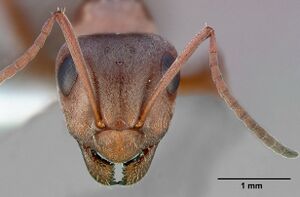Formica aerata
| Formica aerata | |
|---|---|

| |
| Scientific classification | |
| Kingdom: | Animalia |
| Phylum: | Arthropoda |
| Class: | Insecta |
| Order: | Hymenoptera |
| Family: | Formicidae |
| Subfamily: | Formicinae |
| Tribe: | Formicini |
| Genus: | Formica |
| Species: | F. aerata |
| Binomial name | |
| Formica aerata Francoeur, 1973 | |
Identification
Keys including this Species
- Key to Nearctic Formica fusca group males
- Key to Nearctic Formica fusca group queens
- Key to Nearctic Formica fusca group workers
Distribution
California, western Nevada, and southern Oregon.
Latitudinal Distribution Pattern
Latitudinal Range: 41.75° to 33.66344°.
| North Temperate |
North Subtropical |
Tropical | South Subtropical |
South Temperate |
- Source: AntMaps
Distribution based on Regional Taxon Lists
Nearctic Region: United States (type locality).
Distribution based on AntMaps
Distribution based on AntWeb specimens
Check data from AntWeb
Countries Occupied
| Number of countries occupied by this species based on AntWiki Regional Taxon Lists. In general, fewer countries occupied indicates a narrower range, while more countries indicates a more widespread species. |

|
Estimated Abundance
| Relative abundance based on number of AntMaps records per species (this species within the purple bar). Fewer records (to the left) indicates a less abundant/encountered species while more records (to the right) indicates more abundant/encountered species. |

|
Biology
Nevada, Wheeler and Wheeler (1986) - Formica aerata is restricted to the midwestern part of the state. We have 61 records from 37 localities; 3,900-8,200 ft., but 75% are between 4,000 ft. and 4,900 ft. Thirty-five of these records are from the Cool Desert, but only 2 are from pure sagebrush habitat; the remainder are scattered thus: 2 from Sarcobatus Subclimax, 4 from cottonwood groves, 8 from disturbed cottonwood groves, 12 from cottonwood riparian, 4 from riparian, and 3 from disturbed habitat. Only 1 was from the Coniferous Forest Biome. Seven nests were under stones, 1 was under slightly buried wood. Four nests were surmounted by messy craters 50-150 mm in diameter and 3 by messy irregular mounds of soil. Workers were fast and timid. They were often seen ascending and descending cottonwood trunks. Workers tended Macrosiphoniella zerothermum (Knowlton and Russell) (Homoptera: Aphididae; det. L.M. Russell) on Artemisia tridentate at Sonoma Stage Sta., Lyon Co., 6,100 ft.
Association with Other Organisms
 Explore: Show all Associate data or Search these data. See also a list of all data tables or learn how data is managed.
Explore: Show all Associate data or Search these data. See also a list of all data tables or learn how data is managed.
- This species is a host for the ant Polyergus mexicanus (a slave maker) (properly Polyergus umbratus).
- This species is a host for the aphelinid wasp Aphytis melinus (a parasite) (Universal Chalcidoidea Database) (associate).
- This species is a associate (details unknown) for the encyrtid wasp Comperiella bifasciata (a associate (details unknown)) (Quevillon, 2018).
Castes
Images from AntWeb

| |
| Worker. Specimen code casent0005359. Photographer April Nobile, uploaded by California Academy of Sciences. | Owned by UCDC, Davis, CA, USA. |
Nomenclature
The following information is derived from Barry Bolton's Online Catalogue of the Ants of the World.
- aerata. Formica aerata Francoeur, 1973: 116, figs. 183-189 (w.q.) U.S.A.
Unless otherwise noted the text for the remainder of this section is reported from the publication that includes the original description.
Description
References
- Borowiec, M.L., Cover, S.P., Rabeling, C. 2021. The evolution of social parasitism in Formica ants revealed by a global phylogeny. Proceedings of the National Academy of Sciences 118, e2026029118 (doi:10.1073/pnas.2026029118).
- Francoeur, A. 1973. Révision taxonomique des espèces néarctiques du groupe fusca, genre Formica (Formicidae, Hymenoptera). Mém. Soc. Entomol. Qué. 3: 1-316 (page 116, figs. 183-189 worker, queen described)
- Wheeler, G. C. and J. Wheeler. 1986. The ants of Nevada. Natural History Museum of Los Angeles County, Los Angeles.
References based on Global Ant Biodiversity Informatics
- Allred D. M. 1982. Ants of Utah. The Great Basin Naturalist 42: 415-511.
- Allred, D.M. 1982. The ants of Utah. Great Basin Naturalist 42:415-511.
- Francoeur A., and R. R. Snelling. 1979. Notes for a revision of the ant genus Formica. 2. Reidentifications for some specimens from the T. W. Cook collection and new distribution data (Hymenoptera: Formicidae). Contr. Sci. (Los Angel.) 309: 1-7.
- Francoeur. A. 1973. Revision taxonomique des especes nearctiques du group fusca, genre Formica. Memoires de la Societe Entomologique du Quebec 3: 1-316.
- Holway D.A. 1998. Effect of Argentine ant invasions on ground-dwelling arthropods in northern California riparian woodlands. Oecologia. 116: 252-258
- Johnson R. Personnal Database. Accessed on February 5th 2014 at http://www.asu.edu/clas/sirgtools/resources.htm
- Ward P. S. 1987. Distribution of the introduced Argentine ant (Iridomyrmex humilis) in natural habitats of the lower Sacramento Valley and its effects on the indigenous ant fauna. Hilgardia 55: 1-16
- Wheeler G. C., and J. Wheeler. 1986. The ants of Nevada. Los Angeles: Natural History Museum of Los Angeles County, vii + 138 pp.
- Pages using DynamicPageList3 parser function
- North temperate
- North subtropical
- Ant Associate
- Host of Polyergus mexicanus
- Aphelinid wasp Associate
- Host of Aphytis melinus
- Encyrtid wasp Associate
- Host of Comperiella bifasciata
- Species
- Extant species
- Formicidae
- Formicinae
- Formicini
- Formica
- Formica aerata
- Formicinae species
- Formicini species
- Formica species
- Need Overview
- Need Body Text
- Fusca group


